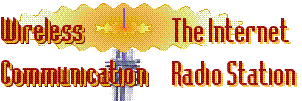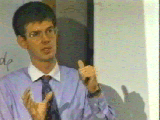
JavaScriptTM
- Path loss, including Egli, Hata
- Indoor path loss
- Single knife edge diffraction loss
- Erlang B
- Spectrum efficiency
- Outage probability:
- Comprehensive: Rayleigh fading, shadowing
- Rician fading
- Gold sequences: crosscorrelation
- Probability density of power sum of multiple lognormal signals (Schwartz & Yee)
- Effective throughput, packet length
- BER
SPECs
Special Purpose Embedded
Calculators

Fairy Tale
In our discussion, Jim Massey tells the anecodete of Viterbi's paper about his ML detector.

Applets
Olivier Swedor, EPFL, Lausanne, created a Java animation for the Viterbi decoder.
Our applet on Rayleigh fading remains as popular as ever.
 Video
Video
Several new tutorials have been included, in the SMIL animated audio format.
![]()
Exercises
See the "educational tools" page, for a list of exercises, quizzes and design problems.
- Tim Moulsley presents a First Course on Wireless Communication. His presentation comes with interactive questions but is also available without questions.
- Short courses on radio wave propagation (SMIL part 1, 2), frequency reuse (SMIL) and OFDM (embedded SMIL)
- An exercise on Direct-Sequence CDMA and the rake receiver has been included.
- We made a board game with quiz questions.
- The ALOHA and collision resolution game is new as is a theoretical exercise associated with the game. Rene van de Vleuten updated the ALOHA pages.
- Frits Schoute created an exercise to compare CDMA and OFDM technology for wireless delivery of multimedia content.
New services
Initiatives from our subscribers
Product
Information

Audio

MPEG MP3 Audio
- Jim Massey: a tutorial on the history of coding theory. (Playlist
m3u)
We also interview Jim Massey to learn more about protocol sequences, which provide random access without feedback. - Sergio Verdu gives a tutorial on multi-user detection (intro, full RealAudio)
- Ahmed Tewfik reviews various multi-user receiver designs (Part 1, 2, 3)
- Geert Leus goes into the mathematical details of the signal processing for multi-user detection. (full Real audio)
- Peter Grant covers array processing for CDMA. He received a 'distinguished IEEE lecturer' award for this presentation. (Part 1-40)
- Bob Brodersen (U.C. Berkeley) doesn't believe that Software Radio is the best approach to future receiver designs. (Part 1, 2, 3)
- Jaap Haartsen (Ericsson) explains the Bluetooth standard for digital interconnection of cell phones, Consumer Electronic and computer devices. (SMIL file)
- Helmut Boelscei (Stanford) addresses OFDM, in particular the pulse shapes and the vulnerability to Doppler spreads (1, 2, 3)
- Jeff Andersen of SONY USA explains the use of OFDM in local-area wireless networks (Part 1, 2, 3, 4)
- Rudi Bekkers of TU/e gives an overview of private mobile radio. (Part 1, 2)
- Geert Awater (Lucent) explains the modulation method of Hiperlan II. (Part 1, 2, 3, 4)
- Phil Karn of Qualcomm presents his 'CDMA and the Internet' experience.
- Randy Katz' History of Communication, from smoke signals to the Internet (playlist.m3u)
- The Story of BS and MS
- Frits Schoute (T.U. Delft) explains the limitations of the erlang traffic models (part 1, 2)
- Alle-Jan van der Veen (T.U. Delft) about developments in DSP (Part 1, 2)
- Ramjee Prasad (Aalburg U. of T.) sees a growing importance of multimedia traffic engineering for wireless networks. (Part 1)
- Hanna Bogucka studied MC-CDMA and combines the DS-CDMA spreading and OFDM modulation into a single operation (part 1, 2).
- Justin Chuang (AT&T) explains the ideas behind EDGE, an extension of GSM. (Part 1, 2, 3) He presents a vision on frequency reuse for multimedia traffic.
- Luc Vandendorpe (Louvain-La-Neuve) communicates over power lines. (Part 1)
- Peter Simons addresses the history of broadcasting, sees an increasing demand for spectrum (spectrum scarcity), and discusses new access techniques for high speed traffic (ADSL) He also covers convergence between TV, PC and the telephone, and he asks himself whether TV is dead?
Responses to questions from subscribers:
Rain and propagation
OFDM and DFT's
MC-CDMA
Our playlists provide a convenient way of listening to audio from this CD-ROM. A daily radio program is transmitted over the internet.
HTML
You will find more in-depth html pages in this issue.
- Gilbert's Markov model for fades and non-fades
- Spreading Sequences
- Antenna gain
- COST 207 reference models for delay spread
- MC-CDMA, in particular the receiver design
- Doppler in OFDM radio links
- CDMA Array Processing
- 2.5G, UMTS
- Viterbi Algorithm
Our glossary translates the buzz words of wireless communication into German, Spanish, Italian, Japanese, Chinese, French or Dutch. The Spanish translation comes with pronounciation examples.
Many mathematical symbols used on this CD-ROM are also listed.
Based on submission from various authors, we decided to create a new section with powerpoint slides. It includes
- Bluetooth by Jaap Haartsen.
- We edited the propagation slide show. It is now also available as Powerpoint slides with annotations. (Basics, Intermediate)
- A slide show on CDMA has been included.
- UMTS slides by Raul Brozzone.
- Turbo Coding and OFDM by IMEC, Leuven.


 We welcome many new
We welcome many new 


